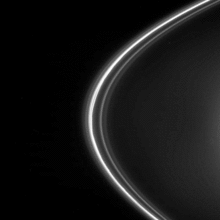
A shepherd moon, also called a herder moon or watcher moon, is a small natural satellite that clears a gap in planetary-ring material or keeps particles within a ring contained. The name is a result of their limiting the "herd" of the ring particles as a shepherd.
Due to their gravitational effect, they pick up particles and deflect them from their original orbits through orbital resonance. This causes gaps in the ring system, such as the particularly striking Cassini Division, as well as other characteristic bands, or strange "twisted" deformation of rings.
Discovery
The existence of shepherd moons was theorized in early 1979.[1] Observations of the rings of Uranus show that they are very thin and well defined, with sharp gaps between rings. To explain this, Goldreich and Tremaine suggested that two small satellites that were undetected at the time might be confining each ring. The first images of shepherd satellites were taken later that year by Voyager 1.[2]
Examples
Jupiter
Several of Jupiter's small innermost moons, namely Metis and Adrastea, are within Jupiter's ring system and are also within Jupiter's Roche limit.[3] It is possible that these rings are composed of material that is being pulled off these two bodies by Jupiter's tidal forces, possibly facilitated by impacts of ring material on their surfaces.
Saturn
The complex ring system of Saturn has several such satellites. These include Prometheus (F ring),[4] Daphnis (Keeler Gap),[5] Pan (Encke Gap),[6] Janus, and Epimetheus (both A ring).[7]
Uranus
Uranus also has shepherd moons on its ε ring, Cordelia and Ophelia. They are interior and exterior shepherds, respectively.[8] Both moons are well within Uranus's synchronous orbit radius, and their orbits are therefore slowly decaying due to tidal deceleration.[9]
Neptune
Neptune's rings are very unusual in that they first appeared to be composed of incomplete arcs in Earth-based observations, but Voyager 2's images showed them to be complete rings with bright clumps.[10] It is thought[11] that the gravitational influence of the shepherd moon Galatea and possibly other as-yet undiscovered shepherd moons are responsible for this clumpiness.
Minor planets
Rings around some centaurs have been identified. Chariklo's rings are remarkably well-defined and are suspected to either be very young or kept in place by a shepherd moon similar in mass to the rings.[12] Chiron is also thought to have rings similar in form to those of Chariklo.[13]
Exoplanets
A major gap in the large ring system of the V1400 Centauri b object at about 61 million km (0.4 AU) from its center is considered to be indirect evidence of the existence of an exomoon with mass up to 0.8 Earth masses.[14][15]
See also
- Kirkwood gap
- Subsatellite (a moon of a moon)
References
- ↑ Goldreich, Peter; Tremaine, Scott (1979). "Towards a theory for the Uranian rings" (PDF). Nature. 277 (5692): 97–99. Bibcode:1979Natur.277...97G. doi:10.1038/277097a0. S2CID 4232962.
- ↑ "Voyager 1".
- ↑ Faure, Gunter; Mensing, Teresa (2007). Introduction to Planetary Science: The Geological Perspective. Springer. ISBN 978-1-4020-5233-0.
- ↑ "On the masses and motions of mini-moons: Pandora's not a". www.planetary.org. Retrieved 2016-06-14.
- ↑ "NASA - Cassini Finds New Saturn Moon That Makes Waves". www.nasa.gov. Retrieved 2016-06-14.
- ↑ Showalter, Mark R. (1991-06-27). "Visual detection of 1981S13, Saturn's eighteenth satellite, and its role in the Encke gap". Nature. 351 (6329): 709–713. Bibcode:1991Natur.351..709S. doi:10.1038/351709a0. S2CID 4317496.
- ↑ Moutamid, Maryame El; Nicholson, Philip D.; French, Richard G.; Tiscareno, Matthew S.; Murray, Carl D.; Evans, Michael W.; French, Colleen McGhee; Hedman, Matthew M.; Burns, Joseph A. (2015-10-01). "How Janus' Orbital Swap Affects the Edge of Saturn's A Ring?". Icarus. 279: 125–140. arXiv:1510.00434. Bibcode:2016Icar..279..125E. doi:10.1016/j.icarus.2015.10.025. S2CID 51785280.
- ↑ Esposito, Larry W. (2002-01-01). "Planetary rings". Reports on Progress in Physics. 65 (12): 1741–1783. Bibcode:2002RPPh...65.1741E. doi:10.1088/0034-4885/65/12/201. ISSN 0034-4885. S2CID 250909885.
- ↑ Karkoschka, Erich (2001-05-01). "Voyager's Eleventh Discovery of a Satellite of Uranus and Photometry and the First Size Measurements of Nine Satellites". Icarus. 151 (1): 69–77. Bibcode:2001Icar..151...69K. doi:10.1006/icar.2001.6597.
- ↑ Miner, Ellis D.; Wessen, Randii R.; Cuzzi, Jeffrey N. (2007). "Present knowledge of the Neptune ring system". Planetary Ring System. Springer Praxis Books. ISBN 978-0-387-34177-4.
- ↑ Salo, Heikki; Hanninen, Jyrki (1998). "Neptune's Partial Rings: Action of Galatea on Self-Gravitating Arc Particles". Science. 282 (5391): 1102–1104. Bibcode:1998Sci...282.1102S. doi:10.1126/science.282.5391.1102. PMID 9804544.
- ↑ Braga-Ribas, F.; Sicardy, B.; Ortiz, J. L.; Snodgrass, C.; Roques, F.; Vieira-Martins, R.; Camargo, J. I. B.; Assafin, M.; Duffard, R. (April 2014). "A ring system detected around the Centaur (10199) Chariklo". Nature. 508 (7494): 72–75. arXiv:1409.7259. Bibcode:2014Natur.508...72B. doi:10.1038/nature13155. PMID 24670644. S2CID 4467484.
- ↑ Ortiz, J. L.; Duffard, R.; Pinilla-Alonso, N.; Alvarez-Candal, A.; Santos-Sanz, P.; Morales, N.; Fernández-Valenzuela, E.; Licandro, J.; Bagatin, A. Campo (2015). "Possible ring material around centaur (2060) Chiron". Astronomy & Astrophysics. 576: A18. arXiv:1501.05911. Bibcode:2015A&A...576A..18O. doi:10.1051/0004-6361/201424461. ISSN 0004-6361. S2CID 38950384.
- ↑ Kenworthy, Matthew A.; Mamajek, Eric E. (January 22, 2015). "Modeling giant extrasolar ring systems in eclipse and the case of J1407b: sculpting by exomoons?". The Astrophysical Journal. 800 (2): 126. arXiv:1501.05652. Bibcode:2015ApJ...800..126K. doi:10.1088/0004-637X/800/2/126. S2CID 56118870.
- ↑ Sutton, P. J. (2019). "Mean motion resonances with nearby moons: an unlikely origin for the gaps observed in the ring around the exoplanet J1407b". Monthly Notices of the Royal Astronomical Society. 486 (2): 1681–1689. arXiv:1902.09285. Bibcode:2019MNRAS.486.1681S. doi:10.1093/mnras/stz563. S2CID 119546405.
Further reading
- Arnold Hanslmeier: Einführung in Astronomie und Astrophysik. Spektrum, Berlin/Heidelberg 2007, ISBN 978-3-8274-1846-3.